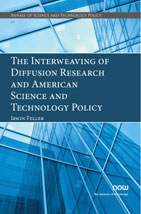The Interweaving of Diffusion Research and American Science and Technology Policy
By Irwin Feller, Professor Emeritus, Economics, Pennsylvania State University, USA, iqf@psu.edu
Abstract
This monograph interweaves an intellectual history of theories of the diffusion of innovations with a brief history of US science and technology policies between 1960 and the present, tracking thereby their independent developments as well as their relative influences on each other. The monograph's opening line of analysis treats diffusion research as a discrete field of study, focusing on the intellectual ferment in the 1960s and 1970s in which new, or more precisely expanded, discipline-based paradigms emerged in economics, political science, geography, and organizational theory to variously complement and compete with longer standing research traditions in anthropology, sociology and communications. A second line of analysis reinterprets major developments in US science and technology policy — Johnson's Great Society; Nixon's New Federalism; international economic competitiveness-in terms of the fluctuating recourse in these policies to findings advanced by diffusion research, and reciprocally the impacts of changing national and state science and technology policy agendas on the salience and direction of diffusion research. A concluding section describes the status of academic interest and external funding in diffusion research circa 2000 to the present, noting also the current limited ties between this research and science and technology policy formulation.
The Interweaving of Diffusion Research and American Science and Technology Policy
This monograph weaves together a history of theories of the diffusion of innovations in selected academic disciplines, tracing the influence of these theories in the formulation of national science and technology policies for 1960 to present. The monograph moves along two main warps — disciplinary traditions of diffusion research and a synoptic history of U.S. science and technology policy — weaving them together at times and in places to demonstrate both their singular threads and crisscrossing patterns.
Given the monograph's shifting focus back and forth between intellectual history and science and technology policy history over a 50+ year time period, it is useful to first set out the organization. Section 2 describes the concurrent rapid conceptual development and empirical testing in the 1960–1970s of models of diffusion of innovation in economics, geography, political science, and organizational theory that arose alongside but often in competition with prior "traditions of research" in (rural) sociology and anthropology, and the intra- and interdisciplinary battles over competing theories of diffusion for theoretical/disciplinary hegemony and policy relevance. Section 3 shifts from intellectual history to science and technology history. Section 4 describes the shifts beginning in the 1980s and continuing since then in policy agendas, conceptual models, and framing of U.S. science and technology policies and among OECD nations towards economic growth and competitiveness. Section 5 examines the re-emergence in assorted forms of academic interest and external funding in diffusion research circa 2000 to the present, also noting the current limited ties between this research and science and technology policy formulation.
